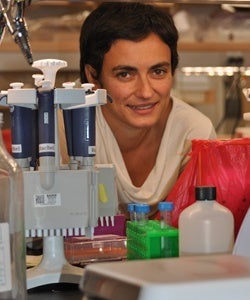Q: You study how genes affect mosquito fertility and mating, a potentially groundbreaking way to prevent malaria transmission. In perfecting this approach, you work with Anopheles gambiae, the chief vector of malaria—but also one of the most notoriously difficult insect species to adapt to the laboratory. What were the technical hurdles?
A: “To reproduce in a laboratory the way mosquitoes mate in the wild is not easy—we had to create our own protocols. To begin with, these mosquitoes mate just once a day. The males get together at sunset and swarm for 10 minutes or so, before it becomes dark. So first, since we study a process that happens briefly at dusk, we created a twilight lighting system that slowly dims the illumination. Second, for females to be inseminated, there has to be a correct ratio between males and females. When the males are swarming, we slowly add females to the cages so we can observe precisely when mating happens and later do time courses in the females to track which genes are induced or repressed. Finally, for females to lay eggs and bear progeny, they need to feed on blood. But it may not be the right time of the day for them to feed, or they may have fed on sugar two minutes before, so they’re not hungry. Sometimes males disturb the females, because the males want to mate while the females want to feed. With mosquitoes, you can draw human parallels.”
